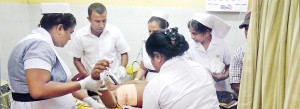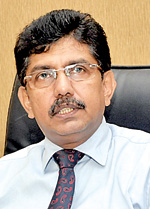Lessons from a tragic accident
Prevention of accidents is always better but in the event of an accident happening, how should those around react in the best interests of the victim?

Critical post accident care:Thushara being attended to at Horana Hospital
Tragically, though 16-year-old Thushara Indunil Lakshan from Bulathsinhala who fell from a mango tree onto a stake of diya para, succumbed to his grievous injuries, in spite of all efforts to save him, there are many lessons that can be taken from this sad accident.
The handling of the seriously injured but conscious teenager from the time he was rushed to the Bulathsinhala Hospital by relatives, then transferred to the Horana Hospital by ambulance and finally sent to the one and only major trauma centre in the country, the Accident and Orthopaedic Service (AOS) of the National Hospital of Sri Lanka (NHSL) shows the skill and efficiency of the state health system.
“The patient’s condition was critical when he was brought in,” says NHSL Director Dr. Anil Jasinghe, pointing out that the relatives rightly had not pulled out the stake piercing the boy’s chest.
When such an injury occurs, there is much damage to tissue, blood vessels and vital organs, he says, explaining that if people try to pull out the stake, the injuries get aggravated, while there is also the danger of massive haemorrhaging (bleeding).

NHSL Director Dr. Anil Jasinghe. Pix by Nilan Maligaspe
“The one-inch thick stake about one-foot long had gone in between the collar-bones just above the breast bone into the right chest cavity. About half a foot was inside and the other half was sticking out of the patient’s chest,” says AOS Consultant General Surgeon, Dr. Amila Jayasekera, who was on duty that afternoon, when Thushara was rushed from the Horana Hospital at about 3.30.
He explains how the Horana Hospital doctors had stringently followed the Advanced Trauma Life Support Protocol in their primary assessment of such life-threatening injury. “They had made sure that the patient’s airway was not compromised, immobilised the cervical spine, evaluated the breathing, checked blood circulation including controlling major external bleeding and assessed the neurological status including the level of consciousness.”
Stressing that prevention of accidents is always better, Dr. Jayasekera gives some important advice to the public on how to deal with such an accident if it does happen. If any tool or stake pierces a person’s body, that person should be brought to hospital with it intact, as an attempt to remove it could cause serious harm and even death. For, when such an injury-causing object is removed there could be torrential haemorrhaging as well as damage to vascular organs.
If the injury-causing object is part of a machine, the machine should be dismantled and the victim brought to hospital with that part intact. The head and body of the injured person should be moved together. The head should be kept aligned with the body by using two blocks on the sides of the head strapped around to prevent movement, while the body too should be strapped to prevent movement.
The spine of the injured person should be kept straight, if possible on a flat board, with no mobilization or minimal mobilization.
If there is bleeding, direct pressure should be applied to stymie it. Depending on the location of the bleed, a tourniquet could be applied but that should be for a limited period of time as otherwise there could be tissue damage. The injured person needs to be taken to hospital immediately.
It would be advisable to take the injured person in a vehicle with room to keep him/her spread out straight and flat. Trishaws should be avoided, as much as possible.
In the case of Thushara, his trachea had escaped injury but the Horana doctors had inserted a plastic intercostal tube into the chest cavity to drain out air or blood that would gather there, as otherwise it could lead to the collapse of the right lung, MediScene learns. Thushara had been transferred on a spinal-board having also been fitted with a cervical collar, while being given blood.
As soon as he was wheeled into the AOS, he had been re-assessed, with a battery of tests including a blood test, basic X-ray and an emergency ultrasound scan (FAST – focused assessment sonography in trauma) being performed. This had been followed by a CT scan (Computed Tomography) of the neck and chest. The scan had revealed blood and also some air in the right chest cavity.
A multidisciplinary team headed by a Senior Consultant Cardiothoracic Surgeon and including two Consultant Anaesthetists had immediately scrubbed up and performed a thoracotomy to remove the stake under direct vision. In a thoracotomy, the pleural space and the pericardium which hold the lungs and the heart respectively are opened up, to give a fighting chance for the teenager to overcome his severe injuries.
It was a major battle that the team waged to save the teenager from the clutches of death. As it is obvious, there is only a thin line between life and death in such serious accidents and despite the team’s valiant attempts, life slipped out of Thushara on October 30.
| Trauma centres urgent need There is an urgent need for Sri Lanka to have at least two more trauma centres in addition to the NHSL’s AOS, is the appeal of Dr. Amila Jayasekera. While transport to hospitals needs to be strengthened, according to him, in other countries there are ambulance and emergency services including helicopters equipped with all facilities to do so. Whenever there is an accident or emergency, the public calls a hotline and awaits such ambulances which are manned by fully-trained para-medics who provide the vital pre-hospital care, adds Dr. Jayasekera.
| |
| The accident On October 27, which was poya, as there were no lessons, Thushara and his gang of friends had found irresistible, the only tree close to their homes in Bulathsinhala still tantalizingly bearing mangoes. Clambering up the mango tree, it took only seconds, like it usually does, for the accident to happen. In the blink of an eyelid, Thushara was hurtling down and there was double jeopardy for him on that fateful morning. Falling about 12 feet as the mango branch gave way was in itself dangerous but what awaited him as he hit the ground, face forward, was worse – it was the stake of diya para. |


